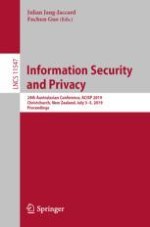This book constitutes the refereed proceedings of the 24th Australasian Conference on Information Security and Privacy, ACISP 2019, held in Christchurch, New Zealand, in July 2019.
The 32 revised full papers and 8 short papers presented were carefully revised and selected from 129 submissions. The papers present and discuss the latest research, trends, breakthroughs, and challenges in the domain of information security, privacy and cybersecurity on a variety of topics such as encryption; post-quantum security; cryptocurrency related; foundations; system and network security; and symmetric cryptography.
